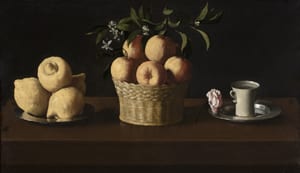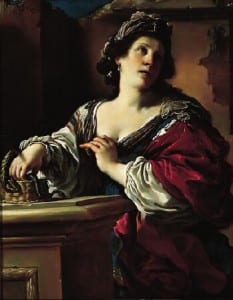Five Baroque Settings from the Norton Simon Museum
Instrumentation: Solo Piano
Duration: 15 Minutes
Premiered by Vicki Ray, Piano Spheres on March 18, 2014
Commissioned by Piano Spheres
These settings were commissioned by Piano Spheres for Vicki Ray. Sometime shortly before starting this piece I went to the Norton Simon Museum in Pasadena. It was the first time ever I did not make a “beeline” straight to the modern exhibit. I was so taken by these Baroque works, that I made subsequent visits back to the museum just to see them again. At the same time I had been talking with Vicki about the idea of virtuosity and what it really means to the performer, specifically to the piano. I was quickly drawn to the parallels between our idea of using different kinds of virtuosity as a technique, similar to the way Baroque artists use contrasting light. Visually light changes our perspective of view, and therefore changes the intensity. For the musician virtuosity can change the listeners perception and also influences the performers technique. My intention was not to “paint” a picture, but rather build my pieces with the same techniques these Baroque artists used, but as a modern musical interpretation. Drama and strong contrasts, all with a sense of motion and tension had to be considered. I intended to capture the instance of the motion in paintings 1, 3 and 5 while movement 2 and 4 act as interludes and are more emotional portrayals of the subject matter.
For each movement I included the notes of each work from the Norton Simon and then my notes on the music follow.
1.The Sense of Touch, c. 1615-16
Jusepe de Ribera
Spanish, 1591-1652
Jusepe de Ribera was one of the giants of seventeenth-century naturalism. The Sense of Touch forms part of an early and famous series of the five senses he created while living in Rome. Ribera, however, intended more than an illustration of one “sense.” He has invited a comparison between the tactile and descriptive qualities of painting and sculpture—that is, between the brush and the chisel.
The artist demonstrates that with touch, sculpture is recognizable to the blind man. Ribera skillfully presents the illusion of a three-dimensional marble object within the confines of the flat surface of the canvas. He then takes one additional, amusing step by including a foreshortened painting that only the sighted can see. Ribera thus asserts the preeminence of painting over sculpture, signifying his stance in the long-standing competition between the art forms (principally architecture, painting and sculpture), known as paragone.
In this movement “touch” is explored first in the upper register in combination with the soft and sustain pedals. The quick tonal flourishes of the opening collide with each other and also consider the key action “noise” of the highest notes. A slow melody emerges out of the resonances of the opening material in different registers, suspended and reserved, creating a sense of space. The long standing musical competition that takes place throughout is between tonal and atonal music. The long falling “tonal” line of the coda lands on a hammered out A major triad only to be masked by it’s own low register and eventually the muffling of the strings, make it just barely recognizable.
View Score
http://issuu.com/jpereiramusic/docs/1._the_sense_of_touch/1
2.Portrait of an Elderly Man, c. 1575
Giovanni Battista Moroni
Italian, c.1525-1578
Moroni can be counted among the greatest portrait painters of the sixteenth century. His brush recorded for posterity, with characteristic Lombard candor, the features of countless men and women of his native Bergamo. His male subjects are deadly serious, their thin lips tight, their eyebrows arched, conscious that they are being studied by the artist. In the present picture, the priming is visible through the thinly applied glazes, and the canvas weave presents its textured surface to the light. The extreme economy of detail is typical of Moroni’s last period. It is a masterpiece of psychological penetration and objectivity and perfectly reflects the ethical values of the Counter-Reformation, which favored truth over idealization.
The first of two shorter interlude movements, and a musical take on a portrait. The old man as the subject, implies the strength of nature, life process, and insight. Time was the focus here, with a complex repetitive chord moving in choral-like motion.
A minimalist approach to texture allows tonal halos to emerge through the blurred lines of the resonance.
3.Suicide of Cleopatra, c. 1621
Giovanni Francesco Barbieri called Guercino
Italian, 1591-1666
Guercino gained the attention of influential patrons with his vigorous naturalism, flickering light effects, and grace of expression. He was in Rome during the brief pontificate of Gregory XV (1621-23), and there produced a number of important works, including “The Suicide of Cleopatra.”
The tragic stories of the queens and heroines of antiquity were popular with Baroque painters, because they contained equal measures of drama, pathos and eroticism. From this remarkable history, Guercino focused on the single, tense moment when Cleopatra, having taken the asp from the basket of figs, is about to raise it to her breast where it will deliver the fatal bite. The dynamic chiaroscuro, supple modelling, and unusual color harmonies give his work its passionate appeal.
Placed right in the middle of the five movements because it contains the most obvious use of chiaroscuro, and here creating the strongest sense of tension of all the paintings. Musically a tremolo, especially between a half step, naturally implies a sense of tension, wanting to be resolved. Starting from a single pitch in a desolate register, the irregular tremolo delays the outbursts about to come. Expanded to a wider set of pitches, played hand to hand, it is again heard as a “broken tremolo”. The performer focuses on the varied attacks, the extreme volumes which “fill the screen”, and is encouraged to often play “tempo rubato” as to adjust the pacing of motion throughout. In the end we are left with an unanswered question of blurred repetitive fifths, leaving this tragic story unfinished.
View Score
http://issuu.com/jpereiramusic/docs/3._suicide_of_cleopatra/1
4.Still Life with Lemons, Oranges and a Rose, 1633
Francisco de Zurbarán
Spanish, 1598-1664
This extraordinary painting by Zurbarán, the only signed and dated still life by this great master of the school of Seville, has been widely admired as a masterpiece of the genre. To devout Spanish Catholics in the 17th century, the apparently humble objects portrayed here contained significant religious meaning. The measured placement of the three motifs, for example, would have been instantly understood as an allusion to the Holy Trinity. The painting has also been interpreted as an homage to the Virgin, with the oranges, their blossoms, and the cup of water symbolizing her purity, and the thornless rose referring to her Immaculate Conception.
Zurbarán depicted the physical character of the objects, and the space they inhabit, with unparalleled focus and skill. By modeling the rough-skinned yellow citrons with hints of green and russet, he suggests the fruit’s protuberance and weight. The arrangement of the orange leaves creates a rhythm of light and shadow, echoed again in the reflective surfaces of the pewter plates. Presented as a quiet, meditative piece within a shallow, minimally described space, this still life evokes a mystical intensity that transcends time in its appeal.
A recent cleaning has removed opaque layers of varnish and discolored retouches, revealing once again the clearly defined edges of the table, the four decorative inlays at each corner, and Zurbarán’s characteristic skill in describing the rough, textural skin of the citrus fruit. The welcome balance between the dark, atmospheric background, the warm tones of the fruit and basket, and the cooler tones of the silver plate and ceramic cup have been restored.
The second of the shorter “portrait” movements, attempts to capture the idea of symbolism. The three “objects” are stated as three separate textures each clearly in it’s own register. The sense of light and shadow is implied by the extreme registers used and the performers treatment of each individual line. Tonal music against the overtones and subtle noise effects adds to the contrasts in detail. The three “objets” are:
-the simple lowest Eflat, first stopped and then played throughout right on the string sounding as if a drone.
-the simple melody of the middle register.
-the distant right hand tremolos of the highest register echoing the overtones and the “noise” sounds of the Eflat drone.
Together all of this minimal movement slowly evolving from left to right, or here low to high, is suspended, mystical, and balanced.
5. Martha Rebuking Mary for Her Vanity, after 1660
Guido Cagnacci
Italian, 1601-1663
The scene of Mary Magdalene’s repentance was frequently depicted by painters in the seventeenth-century. Cagnacci, however, created a unique version of this episode. He combined reality, idealism and fantasy into one, vivid allegory of Virtue triumphing over Vice. His satisfaction with the results is evident, as he signed himself “inventor.”
At center, a penitent Magdalene is rebuked by Martha. The confusion of clothes and jewels cast aside suggests her desertion of vanity. Behind them an angel (Virtue) chases out a devil (Vice). The handmaids at the door reiterate these contrasts. The crying woman represents “contrition”; the other, gesturing in annoyance, represents “vanity.” This brilliant tableau combines lofty allegory with sensuous representation to create an inventive, but effective visual metaphor.
Again, focusing on a dramatic moment with contrasting elements all pitted against each other to create movement. The material is laid out on three separate staves. The middle stave symbolizing Mary, with dense tonal sounding chords, trepidatiously progressing-these chords themselves often conflicted. The upper (virtue) and lower (vice) staves could be Martha, or the angel and then the devil in the bass staff. The upper line crying out with sharp influential attacks and the lower always lurking but sounding indistinct because of the performers use of “catch” pedals. Rhythms start up towards some kind of momentum and then suddenly turn into a fantasy. In the end we are left with the two options echoing as a reminder that the choice is always there to act on.
View Score
http://issuu.com/jpereiramusic/docs/5._martha_rebuking_mary/1



